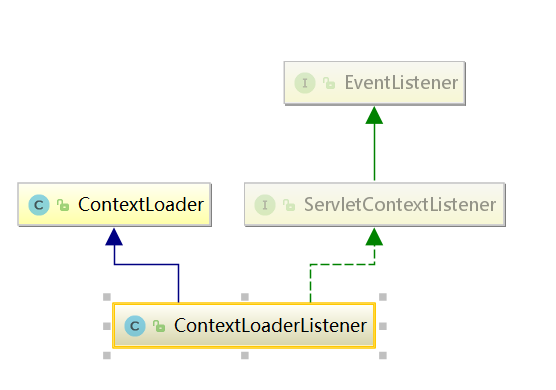研究下springmvc加载过程
基础
在springmvc使用中,我相信大家对其中的web.xml中配置都很熟悉,特别是ContextLoaderListener
和DispatcherServlet
我们先来看下 ContextLoaderListener 类的层次结构

从中我们发现 其继承了 ContextLoader 和实现了 ServletContextListener
现在我们就先从 ContextLoader入手 既然 ContextLoaderListener实现了ServletContextListener,我们知道ServletContextListener我们知道是web容器创建的时候开始执行contextInitialized() 方法,该方法中调用了 initWebApplicationContext(初始化WebApplicationContext对象)方法,
initWebApplicationContext 解析:
//01 首先判断servletContext中是否存在WebApplicationContext实例,如果存在说明ServletContextListener在web.xml中多次声明,并抛出异常。
if (servletContext.getAttribute(WebApplicationContext.ROOT_WEB_APPLICATION_CONTEXT_ATTRIBUTE) != null) {
throw new IllegalStateException("Cannot initialize context because there is already a root application context present - check whether you have multiple ContextLoader* definitions in your web.xml!");
} else {
Log logger = LogFactory.getLog(ContextLoader.class);
servletContext.log("Initializing Spring root WebApplicationContext");
if (logger.isInfoEnabled()) {
logger.info("Root WebApplicationContext: initialization started");
}
long startTime = System.currentTimeMillis();
try {
if (this.context == null) {
//02 调用 createWebApplicationContext() 方法创建WebApplicationContext实例
this.context = this.createWebApplicationContext(servletContext);
}
if (this.context instanceof ConfigurableWebApplicationContext) {
ConfigurableWebApplicationContext cwac = (ConfigurableWebApplicationContext)this.context;
if (!cwac.isActive()) {
if (cwac.getParent() == null) {
ApplicationContext parent = this.loadParentContext(servletContext);
cwac.setParent(parent);
}
//03 调用configureAndRefreshWebApplicationContext() 方法通过WebApplicationContext进行解析web.xml中配置的applicationContext.xml
this.configureAndRefreshWebApplicationContext(cwac, servletContext);
}
}
//04 把WebApplicationContext实例添加到ServletContext中
servletContext.setAttribute(WebApplicationContext.ROOT_WEB_APPLICATION_CONTEXT_ATTRIBUTE, this.context);
createWebApplicationContext 方法: 过createWebApplicationContext(servletContext)创建root上下文(即IOC容器), 之后Spring会以WebApplicationContext.ROOTWEBAPPLICATIONCONTEXTATTRIBUTE属性为Key,将该root上下文存储到ServletContext中
protected WebApplicationContext createWebApplicationContext(ServletContext sc) {
//01 获取WebApplicationContext class实例
Class<?> contextClass = this.determineContextClass(sc);
if (!ConfigurableWebApplicationContext.class.isAssignableFrom(contextClass)) {
throw new ApplicationContextException("Custom context class [" + contextClass.getName() + "] is not of type [" + ConfigurableWebApplicationContext.class.getName() + "]");
} else {
//02 返回WebApplicationContext对象
return (ConfigurableWebApplicationContext)BeanUtils.instantiateClass(contextClass);
}
}
determineContextClass 方法 方法用于查找root上下文的Class类型,如果web.xml中配置了实现ConfigurableWebApplicationContext的contextClass类型就用那个参数, 否则使用默认的XmlWebApplicationContext
protected Class<?> determineContextClass(ServletContext servletContext) {
String contextClassName = servletContext.getInitParameter("contextClass");
//01 判断 servletContext中是否存在contextClass
if (contextClassName != null) {
try {
return ClassUtils.forName(contextClassName, ClassUtils.getDefaultClassLoader());
} catch (ClassNotFoundException var4) {
throw new ApplicationContextException("Failed to load custom context class [" + contextClassName + "]", var4);
}
} else {
//02 从defaultStrategies中通过WebApplicationContext全类名(包名和类名)获取要实现WebApplicationContext接口的类
contextClassName = defaultStrategies.getProperty(WebApplicationContext.class.getName());
try {
return ClassUtils.forName(contextClassName, ContextLoader.class.getClassLoader());
} catch (ClassNotFoundException var5) {
throw new ApplicationContextException("Failed to load default context class [" + contextClassName + "]", var5);
}
}
}
determineContextClass 方法
protected void configureAndRefreshWebApplicationContext(ConfigurableWebApplicationContext wac, ServletContext sc) {
String configLocationParam;
if (ObjectUtils.identityToString(wac).equals(wac.getId())) {
configLocationParam = sc.getInitParameter("contextId");
if (configLocationParam != null) {
wac.setId(configLocationParam);
} else {
wac.setId(ConfigurableWebApplicationContext.APPLICATION_CONTEXT_ID_PREFIX + ObjectUtils.getDisplayString(sc.getContextPath()));
}
}
wac.setServletContext(sc);
//01 获取web.xml中配置的applicationContext.xml路径
configLocationParam = sc.getInitParameter("contextConfigLocation");
if (configLocationParam != null) {
wac.setConfigLocation(configLocationParam);
}
ConfigurableEnvironment env = wac.getEnvironment();
if (env instanceof ConfigurableWebEnvironment) {
((ConfigurableWebEnvironment)env).initPropertySources(sc, (ServletConfig)null);
}
this.customizeContext(sc, wac);
//02 调用refresh()进行加载xml,解析bean
wac.refresh();
}